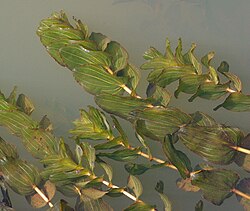Invasive Plants
Curly Leaf Pondweed

Potamogeton crispus — Image by Christian Fischer. Licensed under CC BY-SA 3.0. Source: Wikimedia Commons. Image resized.
Why is curly-leaf pondweed a problem?
In spring, curly-leaf pondweed can form dense mats that may interfere with boating and other recreation on lakes. Curly-leaf also can cause ecological problems because it can displace native aquatic plants. In midsummer, curly-leaf plants usually die back, which results in rafts of dying plants piling up on shorelines, and often is followed by an increase in phosphorus, a nutrient, and undesirable algal blooms. Like other aquatic vegetation, the abundance of curly-leaf varies from year to year depending on environmental conditions, such as winter snow depth, and spring water clarity, which can effect its growth.
Flowering Rush
Image courtesy of the Invading Species Awareness Program. Source: invadingspecies.com
Why is Flowering Rush a Problem?
Flowering rush is actively expanding. It has spread from a limited area around the Great Lakes and the St. Lawrence river to sporadically appear in the northern U.S. and southern Canada. It competes with native shoreland vegetation and over takes all native plant vegetation.
Native Plants
Coontail

“Ceratophyllum demersum (Common Coontail) by J R Crellin, used under CC BY-SA 3.0 /cropped and adjusted from original”
Description: Grows underwater with no roots; upper leaves may reach the surface; central hollow stem has stiff, dark-green leaves; plants may be long and sparse, but are often bushy near the tip, giving the plant a “coontail” or “Christmas tree” appearance.
Importance of plant: Many waterfowl species eat the shoots; it provides cover for young bluegills, perch, largemouth bass, and northern pike; supports insects that fish and ducklings eat. However, when growing densely, commonly causes nuisance conditions along shorelines.
Pondweeds
Largeleaf Pondweed

Potamogeton amplifolius — Image by Charles T. Bryson, USDA Agricultural Research Service. Licensed under CC BY 3.0. Source: Wikimedia Commons. Image resized.
Claspingleaf Pondweed

Potamogeton perfoliatus — Image by Christian Fischer. Licensed under CC BY-SA 3.0. Source: Wikimedia Commons. Image resized.
Floating-leaf Pondweed

Bottom: Potamogeton natans — Image by James H. Miller / USDA NRCS PLANTS Database. Public Domain. Source: Wikimedia Commons. Image resized.
Description: Leaves 2 to 8 inches long; large-leaf and claspingleaf pondweeds grow below the water surface, except for the flowering stalk; floating-leaf pondweed grows below the water surface, except for their flowering stalk and large, floating leaves; all species have thin and delicate submerged leaves, tough stems that are firmly rooted, and a stiff appearance when out of the water.
Importance of plants: Broad-leaf pondweeds provide excellent habitat for panfish, largemouth bass, muskellunge, and northern pike; bluegills nest near these plants and eat insects and other small animals found on the leaves; walleyes use these pondweeds for cover.
Wild Celery
Vallisneria americana — Image by Fredlyfish4. Licensed under CC BY-SA 4.0. Source: Wikimedia Commons. Image resized.
Description: Leaves are ribbon-like, dark-green, and grow below the water surface; rooted in mud; in late summer, produces a small, whitish-yellow flower, supported by a coiled stalk; often grows in beds amid pondweeds and other submerged plants.
Importance of plant: Provides shade and shelter for bluegills, young perch, and largemouth bass; choice food of waterfowl, particularly diving ducks; attracts muskrats, marsh birds, and shore birds.
Where can I take lake weeds?
Visit this resource to learn more: Where can I take lake weeds?

